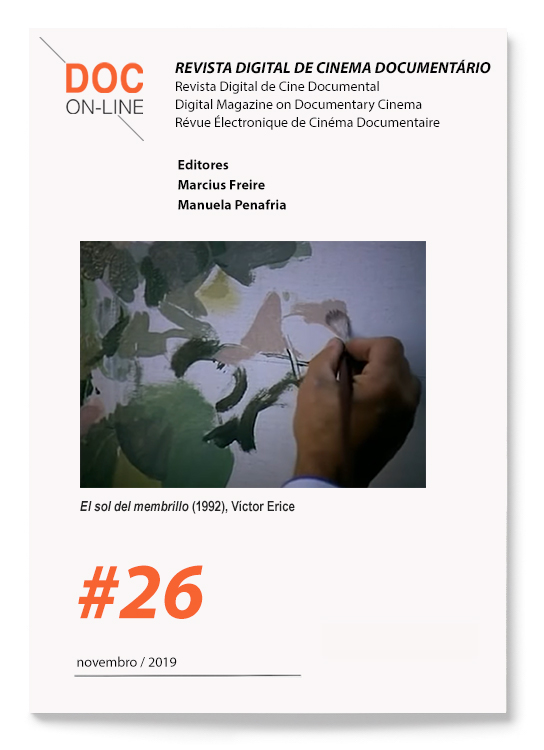Documentário clássico e a voz que não vemos: revisitando as noções de “voz de Deus” e “voz over”
Palavras-chave:
documentário, som fílmico, voz, trilha sonoraResumo
O artigo revisita as noções de “voz de Deus” e “voz over” no âmbito do
filme documentário clássico. A partir de fontes fílmicas e textuais primárias, busca-se demonstrar que tais expressões, por não suportarem as variadas perspectivas estilísticas e éticas do documentário clássico, devem ser reproblematizadas, apontando para a existência de um campo mais complexo e diverso naquilo que envolve a presença da voz.
Referências
And now Rawtenstall. (1936-7). Sight and Sound, 5(20): 155. winter.
Altaman, R. (1985). The evolution of sound technology. In E. Weis & J. Belton (eds.), Film sound: theory and practice (pp. 44-53). New York: Columbia University Press.
Anstey, E. (1966). Some origins of Cinéma vérité and The sound-track in British documentary. Paris: United Nations Educational, Scientific and Cultural Organization.
Arnheim, R. (1985). A new Laocoön: artistic composites and the talking film. In E. Weis & J. Belton (eds.), Film sound: theory and practice (pp. 112-115). New York: Columbia University Press.
B.B.C. The voice of Britain. (1935). Sight and Sound, spring, 4(13): 125-126.
Belton, J. (1985). Technology and aesthetics of film sound. In E. Weis & J. Belton (eds.), Film sound: theory and practice (pp. 63-72). New York: Columbia University Press.
Bird, T. & Farr, W. (1937). The world we live in. Sight and Sound, autumn, 6(23): 145-146.
Bruce, W. (1933). Producing an educational film. Sight and Sound, winter, 1(4): 106-109.
Bruzzi, S. (2000). New documentary: a critical introduction. London: Routledge.
Camera on nature. (1938). World Film News and Television Progress, July, 3(3): 124-125.
Campbell, R. (1978). Cinema strikes back: radical filmmaking in the United States (1930-1942). Michigan: UMI Research Press.
Cavalcanti, A. (1985). Sound in films. In E. Weis & J. Belton (eds.), Film sound: theory and practice (pp. 98-111). New York: Columbia University Press.
Clair, R. (1985). The art of sound. In E. Weis & J. Belton (eds.), Film sound: theory and practice (pp. 92-95). New York: Columbia University Press.
Chion, M. (1994). Audio-vision: sound on screen. New York: Columbia University Press.
Chion, M. (1999). The voice in cinema. New York: Columbia University Press.
Chaves, R. (2015). O som no documentário: a trilha sonora e suas transformações nos principais movimentos e momentos da tradição documentária, dos anos 1920 aos 1960. Dissertação de Mestrado em Multimeios – Instituto de Artes, Departamento de Cinema, Universidade Estadual de Campinas.
Chaves, R. (2016). Pensamentos e práticas sonoras no documentário: trilha sonora, experimentação e sound design. Rebeca, 5: 61-95.
Davy, C. (1935). The Song of Ceylon. Cinema Quarterly, winter, 3(2): 109-110.
Doane, M. A. (1985). The voice in the Cinema: the articulation of body and space. In E.Weis & J. Belton (eds.), Film sound: theory and practice (pp. 54-62). New York: Columbia University Press.
Films for school. (1936). Sight and Sound, autumn, 5(19): 98-99.
Ford, C. & Fairgrieve, J. (1935). Sound or silent/Film is teaching. Sight and Sound, spring, 4(13): 26-30.
Graham, C. (2001). Leni Riefenstahl and Olympia. London: Scarecrow.
Grierson, J. (1933-4) Propaganda: a problem for educational theory and cinema. Sight and Sound, winter, 2(8).
Grierson, J. (1934a). The G.P.O gets sund. Cinema Quarterly, summer, 2(4): 215-221.
Grierson, J. (1934b). Introduction to a new art. Sight and Sound, autumn, 3(10): 101-104.
Guynn, W. (1988). The art of national projection: Basil Wright’s Song of Ceylon. In B. Grant & J. Sloniowski (eds.), Documenting the documentary: close readings of documentary film and video (pp. 64-80). Detroit: Wayne State University Press.
Holmes, J. (1937). G.P.O. films. Sight and Sound, autumn, 6(23): 159-160.
Holmes, W. (1936). The new renaissance. Sight and Sound, summer, 5(18): 7-9.
Industrial Britain. (1934). Sight and Sound, winter, 2(8): 145.
Kracauer, S. (1985). Dialogue and sound. In E. Weis & J. Belton (eds.), Film sound: theory and practice(pp. 126-142). New York: Columbia University Press.
Lins, C. (2006). A voz, o ensaio, o outro. In C. Borges (org.), Angès Varda (pp. 34-39). São Paulo: Centro Cultural Banco do Brasil.
Nichols, B. (1983). The voice of documentary. Film Quarterly, spring, 36(3): 17-30.
Pudovkin, V. (1985). Asynchronism as a principle of sound film. In E.Weis & J. Belton (eds.), Film sound: theory and practice (pp. 86-91). New York: Columbia University Press.
Ramos, F. (2012). A imagem-câmera. Campinas: Papirus.
Ricoeur, P. (2010). Tempo e narrativa, vol. 1: A intriga e a narrativa histórica. São Paulo: WMF Martins Fontes.
Rotha, P. (1939). Documentary film. 2. ed. rev. London: Faber & Faber.
Ruoff, J. (1992). Conventions of Sound in Documentary. In R. Altman, Sound theory, Sound practice (pp. 217-234). New York: Routledge.
Sexton, J. (2004). The audio-visual rhythms of modernity: Song of Ceylon, sound and documentary filmmaking. Scope, May: 1-10.
Stollery, M. (2013). The newsreel commentator, the actor, the intellectual, and the broadcaster: celebrity and personality voices in classic British documentary. Celebrity Studies, 4(2): 202-218.
The Face of Britain. (1935). Sight and Sound, spring, 4(13): 126-127.
Thompson, J. (1935). Documentary films. Sight and Sound, summer, 4(14): 74-75.
Versselo, A. (1936). Night mail. Sight and Sound, spring, 5(17): 28-29.
Wolfe, C. (1997). Historicising the “voice of God”: the place of vocal narration in classical documentary. Film History, 9:149-167.
Wright, B. & Braun, V. (1985). Manifesto: dialogue on sound. In E. Weis & J. Belton (eds.), Film sound: theory and practice (pp. 96-97). New York: Columbia University Press.
Downloads
Publicado
Edição
Secção
Licença
A DOC On-line adota uma Licença Creative Commons - Atribuição 4.0 Internacional que permite a partilha do trabalho com reconhecimento da autoria e publicação inicial na DOC On-line, ou seja:
1) Ao submeter um artigo, os autores cedem os seus direitos de primeira publicação à revista DOC On-line.
2) Após publicação na DOC On-line, os autores poderão re-publicar o seu trabalho, online ou em versão impressa, devendo mencionar a publicação original na revista DOC On-line.


